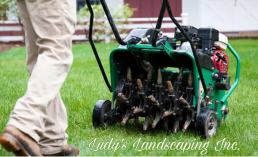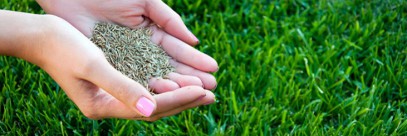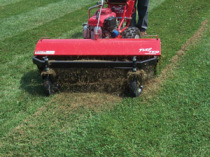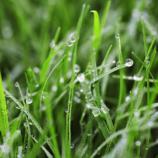Do you want to have a Healthy Lawn?
- Mow 4in High
- Core Aeration
- Fertilizing
- Seeding
- Dethatchin
- Irrigation system
CoreAeration:
helps manage that build-up by introducing thatch-decomposing microorganisms from the soil to the top of the thatch layer. Relieves soil compaction. Compacted soil can prevent air, water, and fertilizer from reaching your lawn's root system, causing dead spots, patches and/or thinning.
Core aeratio
Seeding:
Virginia, early fall is the best time to overseed your lawn. Soil temperatures in the fall are still warm, which promotes optimum seed germination, and cooler air temperatures are better for grass growth. Warm-season weeds are also much less active at this time of year.
you should overseed it in the middle of fall when lawn weeds are dormancy. That way the new grass can become established before its competition.
Get the same variety that currently surrounds your home, You'll be much better off with fresh seed, so check the date on any seed you have laying around before using it.
Time and time again you cut your lawn, leaving at least some clippings behind, which in moderation is excellent for a lawn. However, over time these lawn
clippings, also known as thatch, can prevent water and other nutrients from getting through to the roots of your lawn. The thatch can also provide a great place to hide for insects. In order to
get rid your lawn of this problem, Ludy's Landscaping, Inc. performs a service called detaching. We use a thatching machine and rake to remove the dead grass from the lawn, lime, reseed entire
lawn, slight coat of manure or compost, fertilize, and then water. This will thicken and rejuvenate your lawn and allow for water and nutrients to enter freely.
-
Thatch
-
Thatch is the dead and sometimes living stems and roots found at the base of a lawn. If you look at your lawn and it appears to be brown underneath but still green on top, what you are seeing is most likely thatch.
Causes
-
Thatch is caused primary because grass stems and roots accumulate on the lawn faster than they can decompose. Faster growing grasses, overwatered lawns and grasses excessively fertilized with nitrogen are more likely to produce thatch.
Dethatchers
-
Dethatchers look similar to mowers, but they cut vertically into the soil to bring the organic matter to the surface for removal. Once the thatch is removed, your lawn is ready to seed. Then properly maintain the lawn to prevent thatch.
Prevention/Solution
-
Cut no more than a third of your lawn's height at any one time. Remove the clippings if clumps accumulate. Water deeply and less frequently to get water the grass roots rather than weed roots which tend to grow closer to the surface. Fertilize your lawn according to package instructions.
-
Water in the Morning
The a.m. is the best time to water the lawn because the air is cooler and there's usually not much wind to blow the droplets. In the middle of the day, water evaporates too quickly. And in the evenings, water can cling to the blades of grass overnight, which can cause lawn diseases.
Soak 6 Inches Into the Soil
Water long enough to moisten the soil about 6 inches down, which is the depth of a healthy grass root system. To see how far the moisture seeps down, check the soil every 15 minutes during the first watering.
Go Easy With New Grass pulsating sprinkles work great for lawns with mature grass, but for new yards, the intense water stream can wash away the seeds. Oscillating sprinklers are a better choice for new lawns until the grass takes root.







